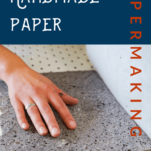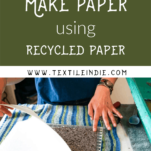This post contains affiliate links. I could be an affiliate for many different products, but I chose these specifically because they are the products and brands I like and recommend. By using my links, you help support this website.
Making handmade paper is a project that’s not only fun but also kind to the planet.
Our paper making guide shows you how to turn old paper and bits of plants from your backyard into something new.
The post walks you through everything you need, from creating pulp to turning pulp into sheets of paper you can actually use in your creative projects.
Experiment with different plants to see what kinds of textures and colors you can create.
Then, use your creations to make unique gift wraps, craft some homemade cards, bookmaking, and collage.
Materials and tools for making petal paper
- 2 pounds of recycled printer paper and cardboard
- 2 pounds of dry plant material
- Kitchen blender
- Handmold Kit
- Sponge
- Towel
- Roller or brayer 4″
- 1 tbsp liquid starch per quart of paper slurry
- 1 Dish tub
- 1 Large tub (larger than the deckle you are using)
- Flat surface to place finished paper
| Papermaking basics | Where to get it? |
| Blender | Any inexpensive kitchen blender |
| Deckle and mould | Arnold Grummer Handmold Kit |
| Sponge | Poly Sponge (Blick) |
| Roller or brayer | Speedball Brayer 4″ (Blick) |
| Liquid starch | Liquid Starch |
| Dish pan | Dish pan |
| Large tub | For bigger frames |
If you’re interested in papermaking with a group, you’ll love this kit from Blick Art Supply:
Arnold Grummer Dip Into Paper Making
Pulp to water ratio
You will want a ratio of one part paper pulp to two parts water.
To make paper that includes recycled paper and plant material, start with equal parts paper and plant material.
Example: If you want to use two pounds of dried plant material then add two pounds of dry recycled paper.

Plants to include in the paper pulp
It’s possible to experiment with any plant material to make paper. However, there are some that work better than others.
For this tutorial, I suggest using grass and leaves from around your yard. These are easy plants to find and make decent paper.
Trial and error is a great teacher. Test out plant materials from your garden to see what makes a good paper and what becomes too brittle or breaks apart.
Processing plants for paper making
The plant materials you use for paper making should be dry.
Even though you will be soaking them in water to create the paper pulp, the initial drying process breaks down the plant so that it is more easily processed, and all extra plant juices are eliminated.
Collect three to four cups of grass clippings and dry them by laying them out on a piece of cardboard or sheet in a dry, warm location. Let them dry for several days until they are brittle to the touch.
Do the same if you choose to use leaves. Collect about a pound of leaves and spread them out in a warm, dry place until they crumble when you crush one in your hands.
Using half a portion of grass and half a portion of leaf materials makes a good balance of plant material added to the recycled paper pulp.

Using a kitchen blender for paper making
Using a kitchen blender for paper making is definitely an option.
When using it to blend up the paper pulp and the plant materials be sure to clean it right away so that the paper bits don’t dry and harden into the nooks and crannies of your blender. Paper pulp doesn’t taste good in a breakfast smoothie.
On that note, I have a separate blender for crafts and paper making. An inexpensive blender will do the trick and prevents cross-contamination. Just because something is “natural” doesn’t mean you want to eat it.
How to make handmade paper
Step 1: Drying the plant material
Dry the plant materials you are going to use. The suggested process for this is outlined above. Once dry, you can begin your paper making.
Step 2: Recycled paper pieces
Collect two pounds of recycled paper and tear it into small pieces.
You’ll get a blender full of slurry using 4 sheets of standard printer paper.
Step 3: Making the slurry
Add paper pieces to a blender and add a quart (2 cups) of water to the paper bits.
Allow the paper to soak in the water for about a minute. Then, blend the paper on low and slowly increase the speed of the blender. Or start with a crush mode and move to a liquify setting.
The slurry is done blending when the outcome is smoothie consistency. There shouldn’t be any lumps in the mixture.
Keep track of how many blenders full of pulp you make. This will determine the amount of liquid starch you add to the mixture.
Step 4: Preparing the dip
Pour the slurry into the large tub and continue the blending process until all the paper pieces have been turned to slurry. Add each blender full to the tub once it forms a smooth slurry.
Now do the same blending process with the dried plant materials. Crunching up the leaves and grass into the blender one to two cups at a time with two cups of water to keep things moving. Do this for all the plant materials you are using and add them to the tub with the paper slurry.
Step 5: Add the starch
Add in the liquid starch. The measurement will vary depending on how much slurry you end up with.
Use the number of blenders worth of material you put into your tub and add one tablespoon of starch per blender.
Stir the slurry with your hand to mix all the paper and plant materials together equally.

Step 6: Dipping the deckle to make paper
Using the paper making deckle slowly and gently dip the deckle just under the surface of the slurry and then lift straight up out of the tub.
Allow the water to drain through the screen over the tub.
It may take a few dips to get an even coating of slurry that is a good thickness. If you can see the screen through the coating, it’s probably too thin, but if you have more than an eighth of an inch of slurry, it will take a long time to dry and will be more like cardboard or cardstock.
Test out different thicknesses to see what you like and what works best.




Step 7: Remove excess water from the dipped paper
Using the sponge or a brayer, press out any excess water from the paper through the deckle screen. Set the deckle on a towel and, using the brayer, roll over the paper to press out more water.
To press out any excess water, you can use a couch sheet laid on top of the dipped paper and roll the brayer over it to soak up more water.




Step 8: Setting the paper to dry
On a flat surface, tip the deckle flat to transfer the paper.
Allow to partially dry and then place a paper towel or dishcloth over the paper and set a heavy book on top so that the paper dries flat.

Step 9: Finishing the paper
Once dry, the paper is ready to use. You can spray the paper with more of the starch if you want it to be stiff and writable. Otherwise, you can use it as is.
Adding pressed flowers
You can add pressed flowers and other additions to your hand dipped paper following the instructions below.
Add rose petals to the paper
- To add the rose petals to the surface of the paper, hold the delicate layer with an even layer of slurry in the water so that the water barely seeps into the layer of slurry. Place the rose petals into the slurry and use your fingers to gently brush bits of the paper pulp over the edges of the petals so that they are held in place.
- Lift the deckle all the way out of the water and allow the excess water to drain out.
- Inspect the rose petals to see that they have some paper pulp holding them in place. If you find a weak patch, scoop a watery palm full of the slurry up, and, holding the deckle over the water, gently pour it over the rose petal in question until the fibers cover it and hold it in place.
This process can be used to add any kind of pressed and dried flowers. Here are some ideas to include in your paper-making projects.
- Dried lavender petals (add these straight into the slurry)
- Pressed flowers: pansies, petals, jasmine, ferns, leaves…
- Plant seeds
- Dried petals
- Pressed or dried herbs
- Herbs and spices
- Essential oils (added to a small batch of slurry or to the drying paper)





